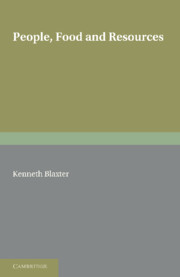4 - NUTRIENTS AND COMMODITIES
Published online by Cambridge University Press: 06 July 2010
Summary
THE MAGNITUDE OF THE TASK
In the two previous chapters emphasis was given to the limitations of both the demographic and nutritional components of the product, likely future number of people in the world times likely future food requirement of the average person. Even so, estimates of both components are necessary to assess the magnitude of the overall problems that beset mankind. One can commence with the population projections made by the World Bank (1984).
The World Bank, drawing on the United Nations' data on population and vital statistics, has undertaken, country by country, an analysis of trends in the basic parameters that determine population size. It has made assumptions about future mortality and future fertility, taking into account the likely success of family planning programmes, to arrive at estimates of the year in which fertility would reach a replacement level. Then demographic methods are employed, which take into account the changing age structure of the population, to provide estimates of the size of the population at equilibrium and the course which population growth will take. It should be noted that the projections assume that each and every country will eventually reduce fertility to a level which results in replacement and no more; it states that a limit to population is inevitable without ascribing any cause.
- Type
- Chapter
- Information
- People, Food and Resources , pp. 48 - 58Publisher: Cambridge University PressPrint publication year: 1986
- 1
- Cited by



